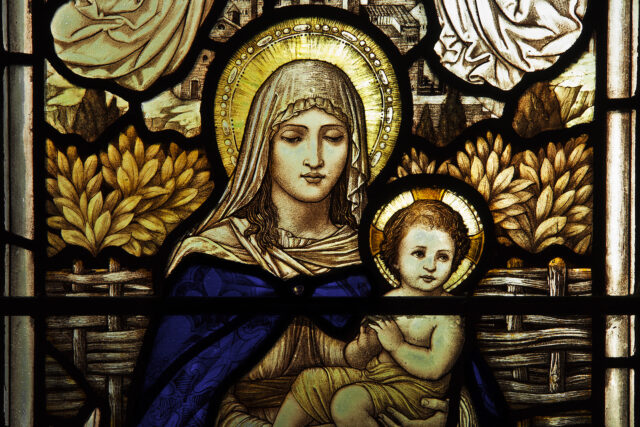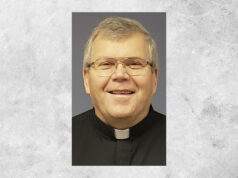By Father James S. Lentini
Holy Cross Parish
Today is Jan. 1, when our nation and most of our world celebrates the beginning of the New Year. In the Catholic church, however, our New Year began Nov. 27, the first Sunday of Advent. So, while we are aware of the national festivities of Jan. 1, we are not so much celebrating the beginning of the New Year as we are celebrating the first born of the new creation: Jesus Christ.
That was Then, This is Now
Putting this in context, for us Jan. 1 is the eighth day of the Christmas Octave (eight days of celebration). It is also the Solemnity of Mary, Mother of God, a day on which we honor Mary’s Motherhood as it brought forth the first born of the new creation, our Lord. Thus, as mankind’s first creation (Adam and Eve) didn’t go so well, and saw mankind booted from paradise, God has given man a time of a new creation, a time of redemption — set in motion, fully, with the birth of Jesus to his Mother Mary.
The Song Remains the Same
This feast day, Mary, Mother of God, was formerly known as the Feast of the Circumcision of the Lord. Of note, the readings, prayers and antiphons for this day never changed, even though the name of the feast day changed. This is because the same person is being honored, but with a change in focus.
- When Jan. 1 was the Feast of the Circumcision of the Lord, the focus was on Mary (and Joseph) bringing the child Jesus for circumcision, as required for all Jewish male children. The focus was on Mary’s faithfulness (doing as God asks, following her faith) and observance of the obligation of God’s law (ensconced in Jewish law) regarding circumcision.
- With the change, in 1969, to Jan. 1 being the Solemnity of Mary, Mother of God, the focus shifts to (1) Mary’s very Motherhood being the result of her faithfulness (saying “yes” to God) and (2) Mary’s observance of God’s law (i.e., as relates to circumcision) not just out of obligation but out of love.
A Girl Named Maria
So, why do we celebrate, on Jan. 1, Mary’s Motherhood. Well, “Mary, Mother of God” is a title bestowed on our Blessed Mother in light of her role as the “theotokos” (God-bearer); it is not a celebration of motherhood (like Mother’s Day is), rather it is a celebration, specifically of Mary’s unique Motherhood. It is a celebration of Mary fulfilling Old Testament prophecy and seen in prefigurations. It is ultimately a celebration of the outcome of Mary’s fiat — her yes to God — bringing forth the first born of the new creation, a new time for man. Thus, Jan. 1, the beginning of a New Year around the world, beckons as a good time for this celebration.
The Union of the Snake
The background for the crux of this holy day takes us back to the Old Testament. Let’s get into the Wayback Machine and set the dial for the era of the Garden of Eden. The Garden was home to Adam (the first “born” of the first creation) and Eve (who came forth from the man, Adam). In that Garden, Adam and Eve, following that snake’s… that serpent’s… that Devil’s temptation, ate from the forbidden fruit of the tree of the knowledge of good and evil — which was the one prohibition God commanded them. After the fall of Adam and Eve, God punishes Adam and Eve, and the Serpent. He says to the Serpent (Satan):
“I will put enmity between you and the woman, and between your offspring and hers; He will strike at your head, while you strike at his heel.” (Genesis 3:15)
I’ve Got a Crush on You
And so it came to pass as the Motherhood of Mary brought these words to fulfillment. Jesus (the firstborn of the new creation) born of Mary (from whom Jesus came forth) is the fulfillment of these words because it was ultimately Him — the Son of God and the son of Mary — who crushed Satan’s head, ultimately conquering death by His sacrifice, by His cross and by His resurrection. This time of the New Covenant, and new creation, had begun when God put enmity between Mary and original sin, preserving her from it. He likewise put enmity between her offspring, Jesus Christ, and Satan’s offspring, evil and death. Thus, Mary is often pictured with a serpent (the Devil) at her feet being crushed.
The Eve of Destruction (and the New Eve)
Further confluences that point to the significance of Mary as Mother of God, are very much seen in the juxtaposition of Mary and Eve. Mary and Eve are two virgins — Mary perpetually, Eve while in the Garden — both of whom had something of importance to do with the fallen state of mankind through their relationship with Christ and Adam. The contrast of what they each did could not be more stark: Eve contributed to the fall of mankind, while Mary contributed to its redemption. Because of this Mary is often called “The New Eve”; one of her titles is the “white dawn” – this reflects that the “eve” is time of the day when the darkness begins to come, while dawn is when the light shines into the world. Mary is the “New Eve” because of her role in reversing fallout from Adam and Eve’s disobedience.
Take a Message to Mary
Jumping ahead in the Old Testament, we take the Wayback Machine to the era of the Prophet Isaiah, who was one of those known as “the Major Prophets.” Isaiah wrote a text famously known as the “Emmanuel Prophecy.” This “Emmanuel Prophecy” historically speaking, is actually talking about the wife of Ahaz, King of Judah, however there is a fuller meaning to this scripture beyond the literal. The Church has continually held that the fuller meaning of this passage puts forth a prophecy relating to Mary. This passage (later reiterated in Matthew 1:23) reads:
“Therefore the Lord himself will give you this sign: the virgin shall be with child, and bear a son, and shall name him Immanuel. He shall be living on curds and honey by the time he learns to reject the bad and choose the good. For before the child learns to reject the bad and choose the good, the land of those two kings whom you dread shall be deserted.” (Isaiah 7:14-16)
Mary Had a Little Lamb
This prophecy, fulfilled in the birth of Jesus, the Lamb of God and our Savior, sees many correlations between the era of the Old Testament and the New Testament. Thus, the word “Emmanuel” which means “God is with us” is, through a reference in the Gospel of St. Matthew, a title distinctly identified with Jesus. Similarly, Jesus was born in poverty of the woman – Mary – just as had been foretold. This point to the doctrine of Mary being a Virgin before, during and after the birth of Jesus (what the Church calls “the threefold virginity of Mary”). It keeps Mary in that unique role by Isaiah words: “The Lord himself will give you this sign” — the virgin who shall “be with child” (before the birth), the virgin who shall “bear a son” (during birth) and virgin who shall “name him Immanuel” (after his birth).
I Will Survive
A further prophecy in the Old Testament, from Micah (one of “The Minor Prophets”) predicts destruction for Jerusalem. This prophecy had also predicted that the Kingdom would be restored, made free, and re-unified by a mighty ruler from a humble town – a ruler whose origins are eternal and who is born of a woman. Sound familiar? Here is what the Prophet Micah wrote:
“Therefore the Lord will give them up, until the time when she who is to give birth has borne, and the rest of his brethren shall return to the children of Israel. He shall stand firm and shepherd his flock by the strength of the Lord, in the majestic name of the Lord, his God; And they shall remain, for now his greatness shall reach to the ends of the earth” (Micah 5:2-3)
Peter, Paul and Mary
That statement that “the Lord will give them up until the time when she who is to give birth has borne…” means, in other words, mankind’s redemption will begin with the incarnation. Thus, the woman being spoken of is, in prefiguration, Mary. The remainder of that passage speaks of his “brethren” (that is his brothers, the Apostles — like Peter, James, Andrew, etc., and later Paul) who do return to the children of Israel, and “reach to the ends of the earth.”
Same Auld Lang Syne
It is by way of these prefigurations and prophecies from the Old Testament, that the ensuing Motherhood of Mary looks back and finds its roots and points forward to its fulfillment. On Jan. 1, as we celebrate the Solemnity of Mary, Mother of God, let us remember the role of Mary, the Theotokos (the God-bearer) and her role in salvation history — a role built around her faithfulness to God, her fullness of grace, and her willingness to be God’s handmaid.
If You Say My Eyes are Beautiful…
As we conclude the Octave of Christmas, and prepare to celebrate the Epiphany (“Three Kings Day”), let’s keep our eyes focused on Jesus Christ, our Savior born unto us. In that regard, there was a song about 30 years ago that stated, “If you say my eyes are beautiful, it’s because they’re looking at you.” Mary’s eyes, and indeed her life, are most beautiful because they focus on Jesus. Let Mary be an example to us in keeping our eyes focused on the Lord. And let us also remember the words of St. Luke’s Gospel that focus our minds and hearts on the birth of our Lord:
In the city of David a savior has been born for you who is Messiah and Lord. And this will be a sign for you: you will find an infant wrapped in swaddling clothes and lying in a manger. And suddenly there was a multitude of the heavenly host with the angel, praising God and saying: ‘Glory to God in the highest and and on earth peace to those on whom his favor rests.’ (Luke 2:11-14)
And in regard to that last line, on Jan. 1, we honor Mary, who indeed “found favor with God” (Luke 1:30) and whose Motherhood was both unique and pivotal “for us men and for our salvation.” (Nicene Creed). Mary, Mother of God, pray for us.







